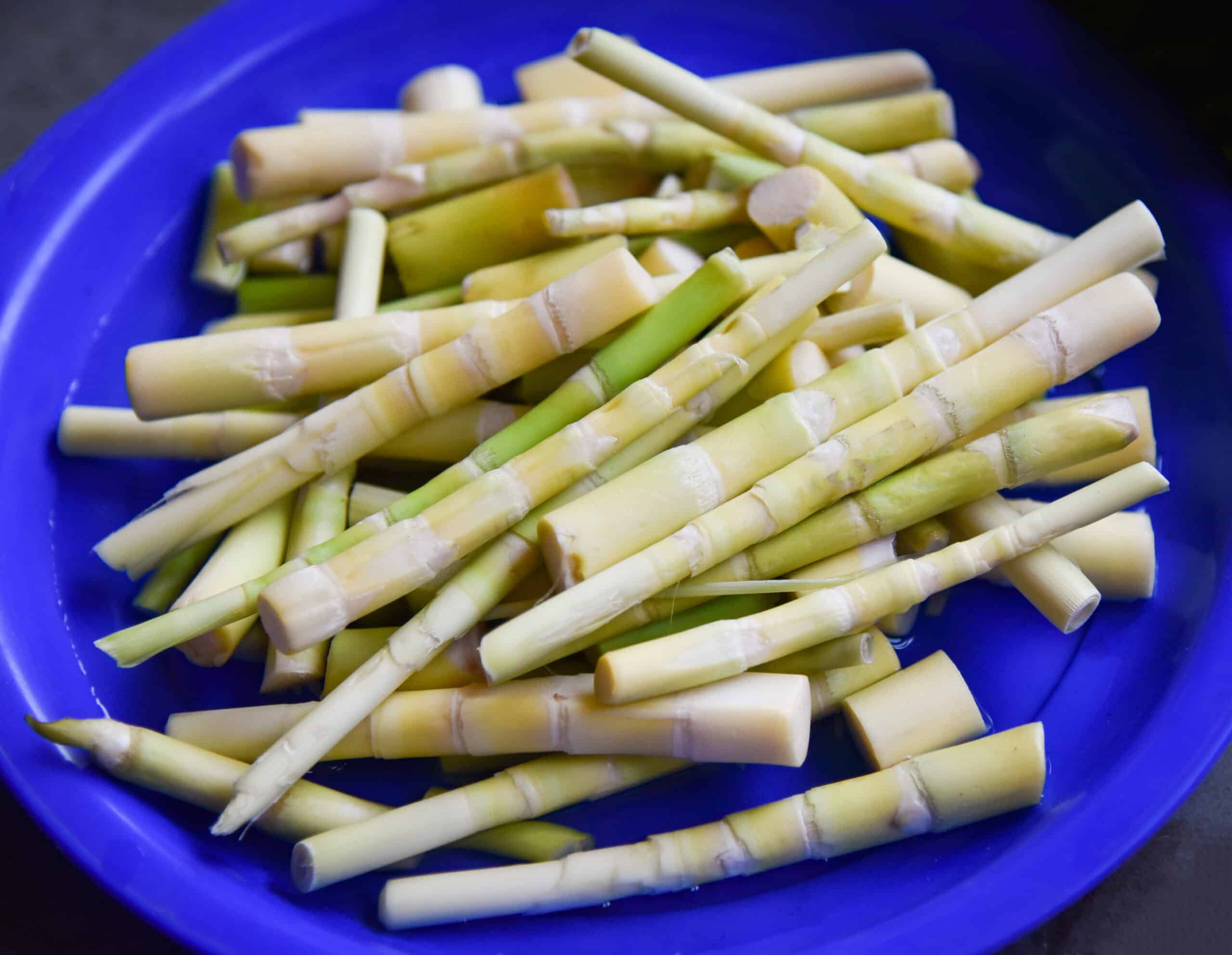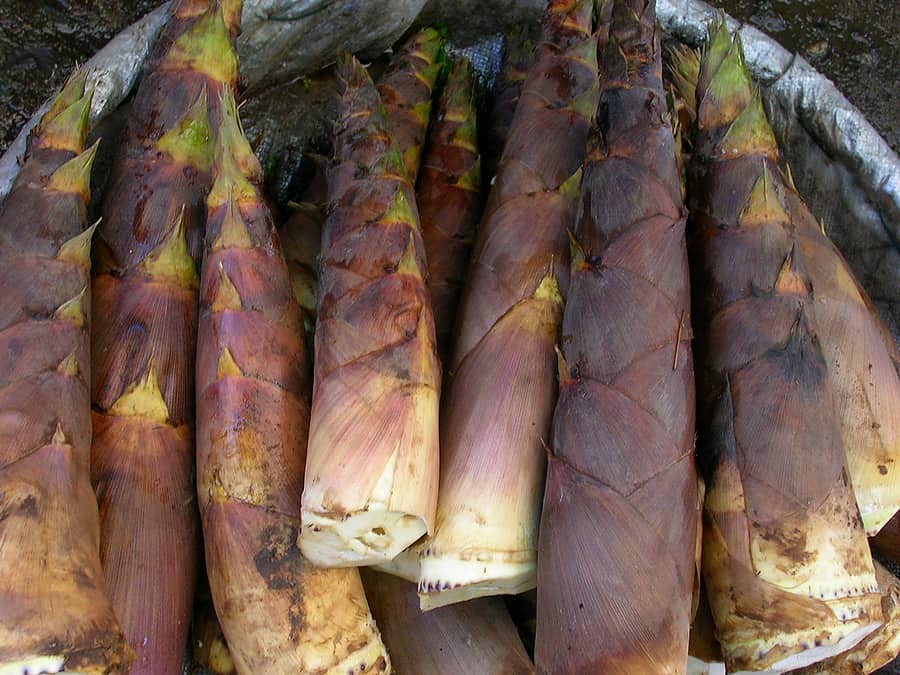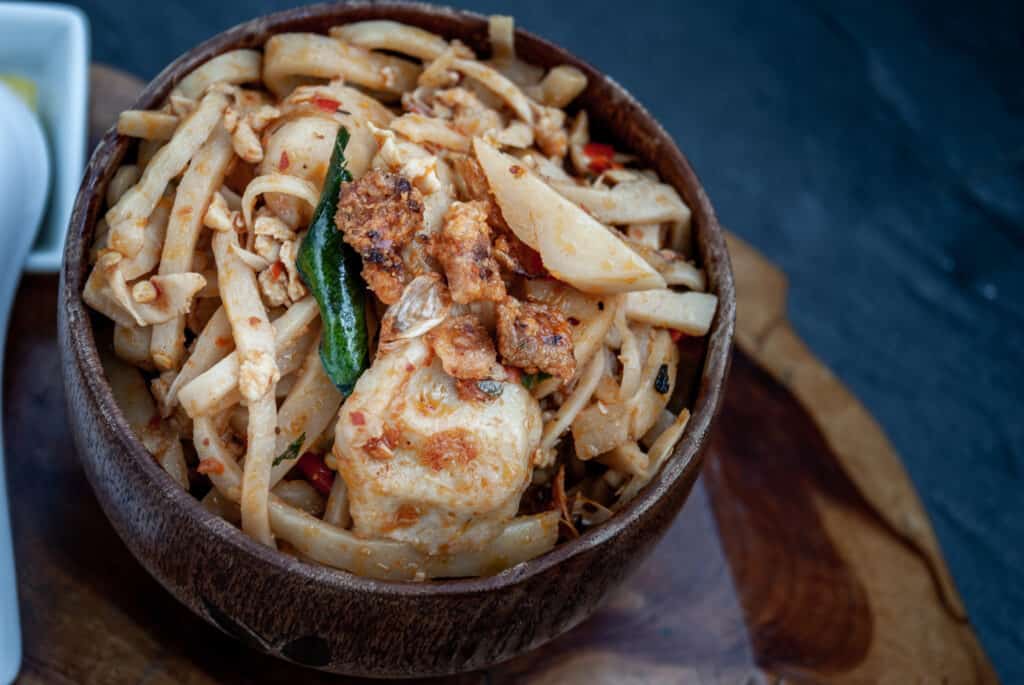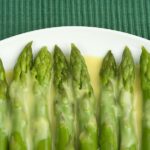Bamboo shoots slowly simmered have a delicate, bitter flavor and earthy aroma.
Fresh bamboo shoots can be sliced and boiled, sautéed or braised, and served as an accompaniment to meat and fish. They can be slow-cooked with other vegetables or stir-fried.

The crunchy texture of young, tender bamboo shoots makes them a great choice served as hors d’oeuvre or stand-alone vegetables. Served with a sauce, bamboo shoots will absorb the flavor of the sauce but still retain their own taste.
Young spring shoots begin to appear in mid-spring.
Kitchen Helpers from Amazon:
- Oster Vegetable Steamer
- Chef’s Knives Set of 6
- EZ Off Jar Opener for Weak Hands
- Pepper Core Remover Stainless Steel
- Kitchen Utensils – Set of 35
How to choose bamboo shoots
- Select bamboo shoots that are short with a wide base and are solid and heavy for their size.
- Avoid soft, moldy, or cracked bamboo shoots or shoots that don’t smell fresh.
How to store bamboo shoots
- Bamboo shoots will keep in the refrigerator for up to 2 weeks if they are unpeeled and wrapped in a paper towel.
- Shoots that have been peeled will keep in the refrigerator for just 1 or 2 days.
- Shoots that are exposed to sunlight will be bitter tasting.

How to prepare bamboo shoots
- Bamboo shoots must be peeled off their brownish husk before eating. Use a knife to make a slit up the side of the shoot. Unwrap and discard the successive layers until you reach the pale edible core. Cut off and discard the pointed tip and fibrous base.
- Boiling: Place the shoot in a saucepan and cover with water and bring to a boil for 20 minutes; change the water and simmer until the shoots are tender. (This procedure will remove the hydrocyanic acid that gives bamboo its bitter taste.)
- If the shoots are still bitter, boil again in fresh water for 5 minutes and repeat until they have a more subtle flavor.

Bamboo shoots serving suggestions
- Bamboo shoots are served after cooking.
- Cut very young shoots into sticks, cubes, or slices and cook in lightly salted water for 30 minutes or until tender.
- Cut into slices, sticks, cubes, or julienne and add to tuna or chicken salad.
- Toss with fried rice or noodles.
- Use to fill spring rolls or dumplings.
- Dip in tempura batter and deep fry.
- Marinate in rice vinegar, sesame oil, and soy sauce.
- Cook in dashi sauce and serve.
- Stir fry with vegetables and chicken.
Bamboo shoots flavor partners
- Bamboo shoots have a flavor affinity for beef, chicken, cilantro, dashi, eggs, ginger, mirin, miso rice, rice noodles, scallions, sesame oil, shiitake mushrooms, soy sauce, fish sauce, and tofu.
Bamboo shoots nutrition
- Bamboo shoots are 94 percent water and are rich in vitamin B and phosphorus.
- Because most of the content of bamboo shoots is water, shoots are most appreciated for their flavor, aroma, crisp texture, and natural look, not their nutritional value.

Get to know bamboo
- Bamboo is a tall woody grass that grows from underground rhizomes. Shoots are hollow stems or buds that form at ground level. Shoots are cone-shaped and measure about 2¾ inches (6.5 cm) in diameter at the base and about 4 to 6 inches (10-15 cm) long at harvest. Each shoot is covered with overlapping scale-like leaves.
- Bamboo is indigenous to Asia where they have been cultivated for thousands of years.
- The bamboo shoot harvest is quick. Spring shoots are cut at the base just as they crack the ground. It is not unusual for bamboo to grow as much as 3 feet (90 cm) in a day.
- There are more than 200 varieties of bamboo, not all of them are edible. The species Phyllostachys pubescens is the most commonly harvested for eating. In Japan, it is called mosochiku. The variety Phyllostachye dulcis is sweet and tender and very popular in China.
- Bamboo shoots are eaten fresh, pickled, and dried in China, Japan, Korea, and most South-East Asian countries.
- In Japan, bamboo shoots are called takenoko. In China, bamboo shoots are called sun ki.
- There are three seasons for bamboo shoots: “winter” shoots are dug from the soil before they ever emerge—they are small and very tender; “spring” shoots are harvested young before they reach more than 10 inches (25 cm) tall, and “summer” shoots are harvested from a late-appearing bamboo variety in summer.
- Spring bamboo shoots are chunky and pale. Winter shoots are small and elongated. Summer shoots are pencil-thin, asparagus-like shoots.
- Cultivated bamboo shoots are often earthed up at the base—a blanching procedure that makes them less bitter.
There are several species of bamboo that can be used for food. The botanical name for the bamboo family is Phyllostachys.
Also of interest:
Asian Greens for Cool Weather Harvest
Related articles:
Best Herbs for Container Growing
Garden Planning Books at Amazon:
- Vegetable Garden Almanac & Planner
- Kitchen Garden Grower’s Guide Vegetable Encyclopedia
- Vegetable Garden Grower’s Guide
- Tomato Grower’s Answer Book
More kitchen tips:
Bring your harvest to the table. Kitchen prep tips and easy recipes for the vegetables you grow. Click below for vegetable prep and recipes you can use now.
- Almonds
- Apples
- Apricot
- Aprium
- Artichoke
- Arugula
- Asparagus
- Avocado
- Bamboo Shoots
- Banana
- Basil
- Beans, Dried
- Beans. Long
- Beans, Shell
- Beans, Snap
- Beets
- Bitter Melon
- Blackberry
- Bok Choy
- Broccoli
- Broccoli Raab
- Brussels Sprouts
- Cabbage
- Cardoon
- Carrots
- Cauliflower
- Celeriac
- Celery
- Chard
- Chayote Squash
- Cherimoya
- Cherries
- Chestnut
- Chickpea
- Chinese Cabbage
- Chives
- Cilantro
- Citron
- Clementine
- Collards
- Coriander
- Corn, Sweet
- Corn, Baby
- Corn Salad, Mache
- Cranberry
- Cress
- Cucumber
- Daikon
- Dandelion
- Dill
- Eggplant
- Endive, Belgian
- Endive and Escarole
- Fava Beans
- Fig
- Florence Fennel
- Garlic
- Ginger
- Grapefruit
- Grapes
- Guava
- Horseradish
- Jerusalem Artichoke
- Jicama
- Jujube
- Kale
- Kiwifruit
- Kohlrabi
- Kumquat
- Leeks
- Lemongrass
- Lemons
- Lettuce
- Lime
- Mache (Corn Salad)
- Mandarin Orange
- Mango
- Maple Syrup
- Marjoram
- Melons
- Michihili
- Mint
- Mizuna
- Mushrooms
- Mushrooms, Cremini
- Mustard Greens
- Napa Cabbage
- Nectarine
- Okra
- Olives
- Olive oil
- Onions
- Oranges
- Oregano
- Parsley
- Parsley Root
- Parsnips
- Passion Fruit
- Pawpaw
- Peaches
- Pears
- Peas, Garden Snap
- Peas, Snow
- Pei Tsai
- Peppers, Chili
- Peppers, Sweet
- Persimmon
- Pineapple
- Pineapple Guava
- Plantain
- Plums
- Pluots
- Pomegranate
- Potatoes
- Prickly Pear
- Pumpkin
- Quince
- Radicchio
- Radishes
- Raspberries
- Rosemary
- Rhubarb
- Rutabaga
- Sage
- Salsify
- Sauerkraut
- Savory
- Shallots
- Sorrel
- Spinach
- Squash, Summer
- Squash, Winter
- Strawberries
- Sunchokes
- Sunflower
- Sweet Potato
- Swiss Chard
- Tangerine
- Taro
- Tarragon
- Thyme
- Tomatillo
- Tomato
- Turnip
- Turnip Greens
- Yams















